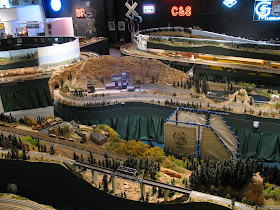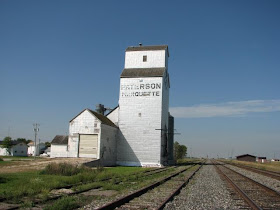 |
Gateway Western III inside the Winnipeg
Railway Museum. |
After 17 years, the Gateway Western is back home in Winnipeg's VIA Station.
For many years, the Gateway Western version I, owned and operated by members of the Winnipeg Model Railroad Club (WMRC), occupied a corner near the rotunda in the historic station.
That layout, which featured a meandering single track mainline that ducked into multiple tunnels and over bridges, was a highlight for many visitors to the station, including passengers de-training during a brief stopover in Winnipeg.
(It was even featured in a 1989 travel article in the
New York Times. Said the writer: "With an hour to while away . . . most of us gathered in one
corner of the massive hall where the Gateway Western Railway, operating division
of the Winnipeg Model Railroad Club, was running its HO scale line through
tunnel-riddled mountainous terrain.")
 |
| A view from inside. |
That layout was dismantled at the request of VIA Rail in 1996. In its place is now a men's washroom; yes, you can now urinate where the tracks once ran.
Soon after, some club members built Gateway Western II, a portable and sectional layout. That layout was sold to a private individual in 2000. When I discovered he had never actually put it back together in his basement, as he intended, I helped arrange for the WMRC to buy it back.
In 2004, it was resurrected in the basement of Gooch's Hobby Shop.
It resided there until 2009, when the hobby shop relocated. After that, it was put into storage, with the hope it might one day find a new home.
 |
| Another inside view. |
That never happened. Last year the WMRC received a request from
Winnipeg Railway Museum to build a new layout inside their facility.
The Museum, which occupies two of the former tracks in the historic train shed at the VIA Station, is a great place for a layout. Unfortunately, it isn't heated or air conditioned, the roof sometimes leaks, and birds sometimes find their way into the Museum (doing what birds do).
 |
| Kids enjoyed watching the trains. |
Prior to the new layout being built, the Museum had bought another portable layout from the
Renegades Model Railroad Club; it wasn't long before that layout deteriorated under those conditions.
That won't happen to the new Gateway Western. WMRC members didn't just build a model railroad--they built a building to put it in, too.
 |
| And so did adults. |
The layout is in a climate-controlled building inside the train shed. The building is done, but right now the layout is only partially finished; club members were able to complete two-thirds of the line before the Sept. 21-22 Railway Days at the Museum--enough to entertain visitors. Over the winter, the rest will be finished.
Eventually, visitors will be able to push a button and make trains run even when no club members are there.
Meantime, it's quite a set up--congrats to everyone who built it! And if you are passing through Winnipeg, by train or any other mode of transportation, make sure to stop by to see the new Gateway in its new home.
 |
BNSF Manitoba 2748 was also on display
during Railway Days, with the new Canadian Museum
of Human Rights in the background. |


















































